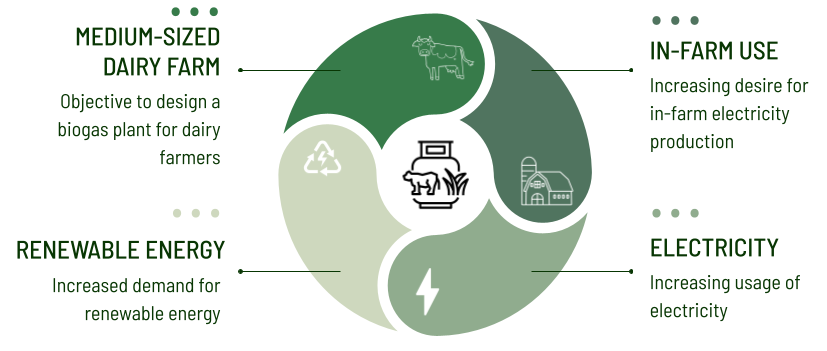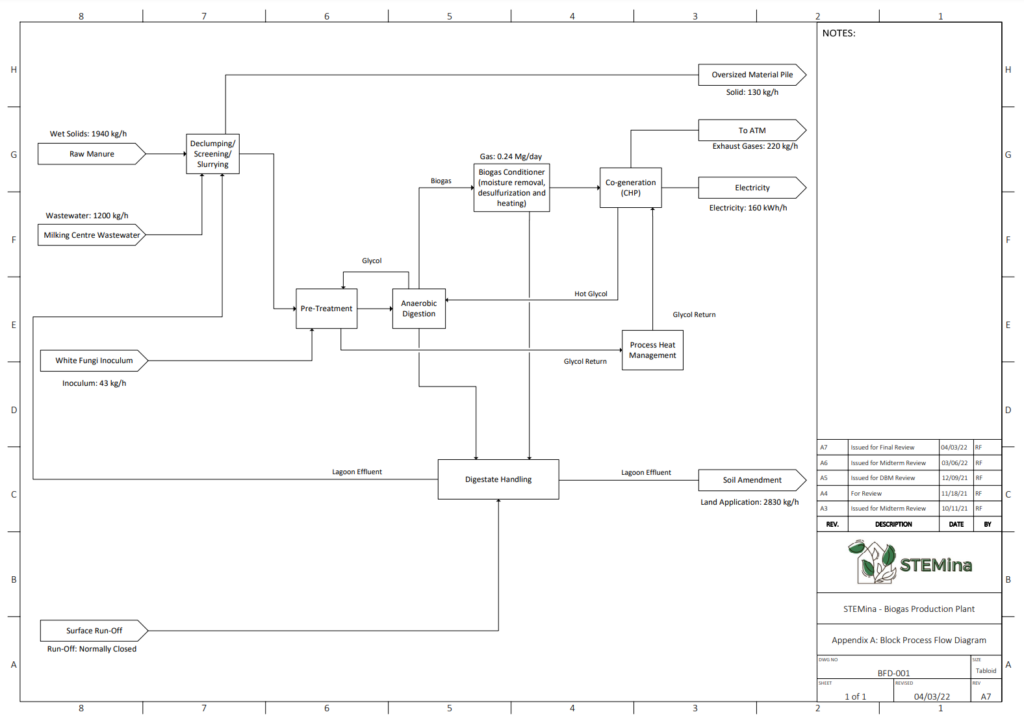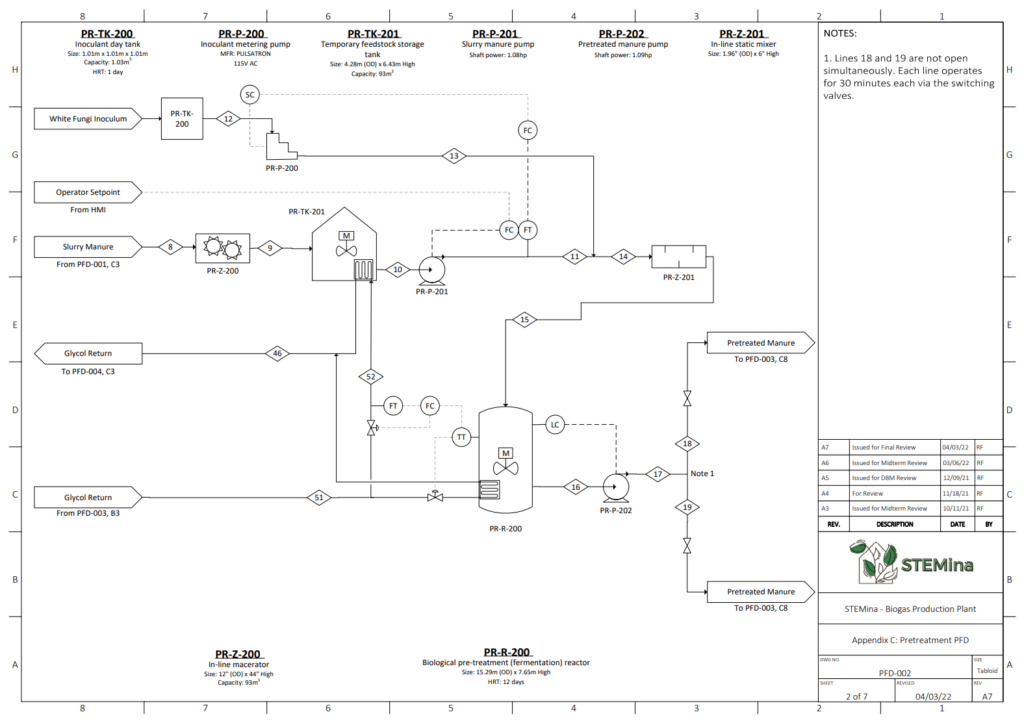Project Category: Chemical

Our goal is to create an economically feasible biogas production plant for in-farm utilization using dairy cow manure.
Tuesday April 5, 2022, 10 AM to 12:30 PM
Project Overview

At STEMina, our objective is to create biogas, a renewable energy source, that is both efficient and economically feasible. With a biogas production plant, farmers will save millions of dollars in electricity and make dairy farms a greener operation. As per our client’s at Obsidian Engineering, the process size, technology options, and various costs have been considered. Impacts to process and operational efficiency, health and safety, environment and overall GHG emissions have also been evaluated. Thus, our 4 main project drivers are: the need to produce a biogas plant for medium-sized dairy farms because of the increasing desire among farmers for in-farm electricity production. This is due to the increasing usage of electricity globally as well as the demand for increased usage of renewable energy.
Our selected process design consists of five steps, beginning with receiving and preparing the cow manure feedstock to enter the pretreatment units for biogas enhancement. It then proceeds to the anaerobic digesters to generate biogas and digestate. The biogas travels to biogas conditioning, which consists of moisture and hydrogen sulfide removal, and then lastly to the cogeneration system to produce electricity and heat for in-farm use.
Overall, from a feed rate of 93 tonnes/day of cow manure from 1000 dairy cows, we are producing 1.4 GWh of electricity annually.

To learn more about our design, watch our video in the link below:
Meet Our STEMina Team

Kimberly Do
STEMina Team Lead

Kristin Wong
Technical SME

Mahek Sharma
Safety SME

Eniola Olowu
Economics SME

Saba Bhatti
Controls SME
Details About Our Design
HOW OUR DESIGN ADDRESSES PRACTICAL ISSUES
With an increasing energy demand amongst dairy farmers, there is a growing interest to design a biogas production process to provide significant cost savings to farm operations while making it a greener operation. Biogas is the preferred choice as it provides a clean, renewable, and reliable source powered by the readily available cow manure present on dairy farms. As such, biogas has been a target of use to STEMina’s clients at Obsidian Engineering. At STEMina, the conversion of dairy cow manure from a 1000-cow medium-sized dairy farm into biogas, used to heat and power the biogas production plant and farm is studied.
As STEMina’s plant is located in Western Canada, consisting of B.C., Alberta, and Saskatchewan, this diversifies the economy through the promotion of a low carbon and renewable energy industry in these provinces.
In the future, STEMina’s process may be adapted to use different organic feedstocks, such as poultry manure, to scale up the production of biogas.
WHAT MAKES OUR DESIGN INNOVATIVE
Have you ever thought about the energy content of cow poop?
Well, you don’t have to as we did! We chose to study biogas production on dairy farms because:
- Manure is easily collected on dairy farms where cows are routinely confined
- As manure is considered waste and has no value, this makes it a good feedstock compared to energy crops such as sugar cane which need additional land area to be grown but also can be used as food
- As manure is a waste product that cannot be used further, utilizing it to create biogas can prevent problems with its disposal while gaining an energy fuel
- Manure is typically obtained from farms and slaughterhouses. Slaughterhouses in general have a lot of ethical issues surrounding them so it would be best to couple this process with a dairy farm instead
- Biogas is most efficient when used directly for heating
- Dairy farms have a year-round demand for hot water
WHAT MAKES OUR DESIGN SOLUTION EFFECTIVE
Our focus is to create biogas, a renewable energy source, that is both efficient and economically feasible. With a biogas production plant, farmers will save millions of dollars in electricity and make dairy farms a greener operation. The process size, technology options, and various costs have been considered while impacts to process and operational efficiency, health and safety, environment and overall GHG emissions have also been evaluated. Thus, 4 core values are:
- Design a biogas plant for dairy farmers
- Increase desire for in-farm electricity production
- Increase electricity usage
- Increase demand for low carbon and renewable energy

HOW WE VALIDATED OUR DESIGN SOLUTION
An extensive literature review and consultation with industry subject matter experts at Obsidian Engineering were conducted to validate STEMina’s final design, and to achieve the optimal efficiency, economic feasibility, and safety in our processes.
STEMina used simulation programs, including VMG Symmetry and Aspen Plus to model the anaerobic digestion and biogas conditioning processes within the plant. In addition, hand calculations were conducted to validate if the simulated models were feasible. Process optimization techniques were also done to validate design assumptions.
FEASIBILITY OF OUR DESIGN SOLUTION
One of the major components of this project was to evaluate the economic feasibility. After literature review, consultation, and optimization, the implementation of a biogas production plant for medium-sized dairy farms was concluded to be economically unfeasible for the average farmer. From the beginning, this was a risk that was apparent to both our clients and us. Although this process is not economically feasible, this project remains to demonstrate the diversity of fuel sources beyond conventional fossil fuels that are used in Western Canada. In addition, the project is still a major success, both by our standards and our client’s, as this is proof-of-concept that a process to upgrade manure waste into biogas is technologically feasible.
One of the major contributing factors to the economic unfeasibility of our plant was the direct and indirect costs. The field constructed equipment accounted for over a quarter of the overall cost and would need to be significantly reduced to be more economically feasible. Although there were significant electricity cost-savings, a high operating cost counteracted the benefits, resulting in a pay-back period that greatly exceeded the standard of 5 years.
Partners and Mentors
STEMina would like to thank everyone who provided their support and assistance to us throughout the Fall 2021 and Winter 2022 semesters. We would especially like to thank the following indiviudals:
We would like to thank our industrial clients, from Obsidian Engineering, Dr. Roderick Facey and Jeremy Zhao, for taking the time out of their busy schedules weekly to mentor us and guide us through the industrial standards and processes. This project would not be possible without your extremely helpful advice, assistance, and guidance.
Finally, we would like to thank our supervisor, Dr. Jinguang Hu. Your support and encouragement has greatly improved STEMina’s productivity. Thank you for your advice and we really appreciated your knowledgeable background.

Our Photo Gallery







References
- A. Wilkie, “Anaerobic digestion of dairy manure: Design and process consideration,” Dairy Manure Management: Treatment, Handling, and Community Relations, pp. 301-312, 2005.
- T. Shelford, C. Gooch, M. Hines, A. Choudhury, G. Felton, S. Lansing, “Farmer’s Guide to Dairy-Derived Biogas Production, Treatment and Utilization,” LNE15-341, pp. 1-78, 2018.
- A. Anukam, A. Mohammadi, M. Naqvi, and K. Granström, “A review of the chemistry of anaerobic digestion: Methods of accelerating and Optimizing Process Efficiency,” Processes, vol. 7, no. 8, p. 504, 2019.
- M.-Q. Orlando and V.-M. Borja, “Pretreatment of animal manure biomass to improve biogas production: A Review,” Energies, vol. 13, no. 14, p. 3573, 2020.
